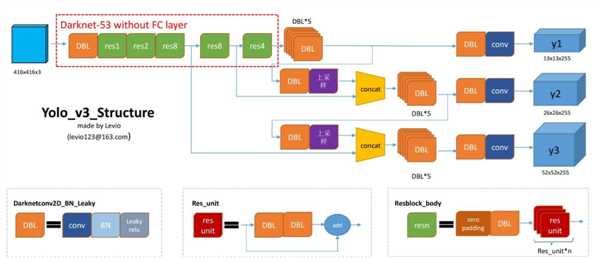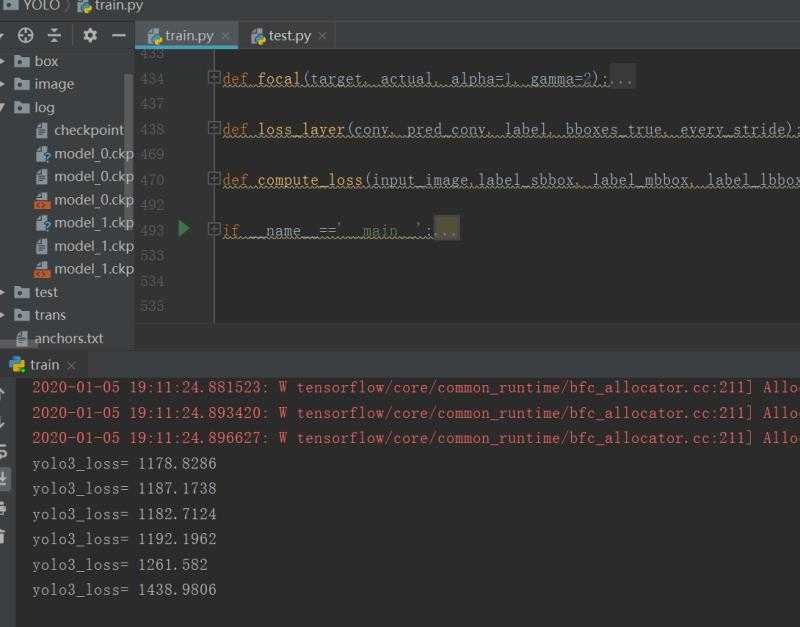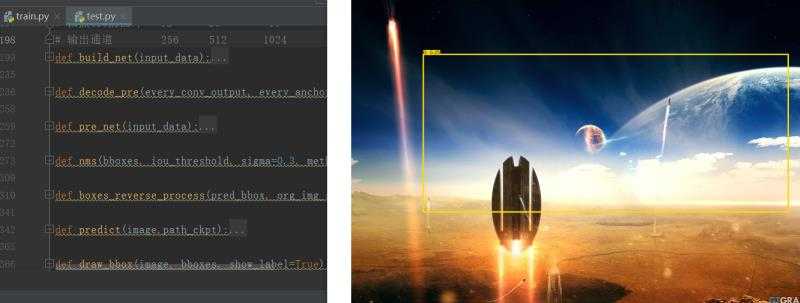YOLO3算法超详细代码分享:手撕测试代码(test)
Posted tangjunjun
tags:
篇首语:本文由小常识网(cha138.com)小编为大家整理,主要介绍了YOLO3算法超详细代码分享:手撕测试代码(test)相关的知识,希望对你有一定的参考价值。
我看了很多博客,也看了一些github大神的源码,很多基于一个版本改写而成。会将代码分成很多小.py文件,如建立YOLO3网络模块就会用一个.py文件,
如建立共用iou计算就会放在utils.py文件里,这让很多学习者,无从适应。我也为此困惑过,因此我将自己写的代码贡献在博客中,希望给你们有一些帮助。
而鉴于已有很多博客对YOLO3理论有很多的详细解说,为此,我将不再赘述,借用网上下图,一笔带过理论。

我声明,我的训练代码只有一个.py文件,训练文件可以单独运行,若需要运行我test文件代码,则需要结合训练文件,主要原因在于权重的载入。
若有任何疑问,欢迎留言讨论。
代码如下:
import os
import numpy as np
import cv2 as cv
import random
import tensorflow as tf
import colorsys
# input_target_size = random.choice(input_target_sizes) # 随机选择一个
input_target_size=320
print(‘input_target_size: ‘,input_target_size)
strides = np.array([8, 16, 32])
print(‘strides: ‘,strides)
output_sizes = input_target_size // strides
print(‘output_sizes: ‘,output_sizes)
# trainable = True # when training,trainable is True to represent Batch normalization is training
# input and output scale for image,input include one figure,output include three figures
# information about general parameters
anchor_scale = 3
print(‘anchor_scale: ‘,anchor_scale)
classes_num = 10
print(‘classes_num: ‘,classes_num)
# batch_size = 1
# print(‘batch_size: ‘,batch_size)
# deta_onehot = 0.001 # 保证one_hot 没有值的类不为0,而是根据类别得到一个很小的一个数(可忽略)
current_master_distance=1 # 当前路径与主路径之间层次的参数,0表示当前路径,1表示当前路径的上级路径
print(‘current_master_distance:‘,current_master_distance)
box_score_threshold=0. # 预测置信度大于该值则保留该框,利用置信度剔除一遍
print(‘box_score_threshold: ‘,box_score_threshold)
box_score_nms=0. # 利用nms剔除重复的框
print(‘box_score_nms: ‘,box_score_nms)
# 寻找需要的路径
def get_path(path_int):
‘‘‘
:param path_int: 0表示获取当前路径,1表示当前路径的上一次路径,2表示当前路径的上2次路径,以此类推
:return: 返回我们需要的绝对路径,是双斜号的绝对路径
‘‘‘
path_count=path_int
path_current=os.path.abspath(r".")
# print(‘path_current=‘,path_current)
path_current_split=path_current.split(‘‘)
# print(‘path_current_split=‘,path_current_split)
path_want=path_current_split[0]
for i in range(len(path_current_split)-1-path_count):
j=i+1
path_want=path_want+‘‘+path_current_split[j]
return path_want
path_master_catalogue=get_path(current_master_distance) # 参数表示当前目录与主目录之间的层次,以此返回主目录
path_general =path_master_catalogue+‘dataanchors.txt‘ # 得到anchor
# print(‘path_general: ‘,path_general)
# information about general parameters
# change image function for target_size
def image_preporcess(image, target_size):
image = cv.cvtColor(image, cv.COLOR_BGR2RGB).astype(np.float32)
ih, iw = target_size
h, w, _ = image.shape
scale = min(iw /w, ih /h)
nw, nh = int(scale * w), int(scale * h)
image_resized = cv.resize(image, (nw, nh))
image_paded = np.full(shape=[ih, iw, 3], fill_value=128.0)
dw, dh = (iw - nw) // 2, (ih -nh) // 2
image_paded[dh:nh +dh, dw:nw +dw, :] = image_resized
image_paded = image_paded / 255.
return image_paded # [xywhc]
# change image function for target_size
# solve iou between three anchors and every true box
def box_iou(boxes1, boxes2):
boxes1 = np.array(boxes1)
boxes2 = np.array(boxes2)
boxes1_area = boxes1[..., 2] * boxes1[..., 3]
boxes2_area = boxes2[..., 2] * boxes2[..., 3]
boxes1 = np.concatenate([boxes1[..., :2] - boxes1[..., 2:] * 0.5, boxes1[..., :2] + boxes1[..., 2:] * 0.5], axis=-1)
boxes2 = np.concatenate([boxes2[..., :2] - boxes2[..., 2:] * 0.5, boxes2[..., :2] + boxes2[..., 2:] * 0.5], axis=-1)
left_up = np.maximum(boxes1[..., :2], boxes2[..., :2])
right_down = np.minimum(boxes1[..., 2:], boxes2[..., 2:])
inter_section = np.maximum(right_down - left_up, 0.0)
inter_area = inter_section[..., 0] * inter_section[..., 1]
union_area = boxes1_area + boxes2_area - inter_area
return inter_area / union_area
# solve iou between three anchors and every true box
def get_anchor(path_general):
# 输入为路径
#得到anchor的矩阵
anchors_path = path_general # modify path for anchors
anchors = open(anchors_path, ‘r‘)
anchors = anchors.readline()
anchors = np.array(anchors.split(‘,‘), dtype=np.float32)
anchors = anchors.reshape(3, 3, 2)
return anchors
# 开始构建网络
with tf.name_scope(‘define_input‘):
input_image = tf.placeholder(dtype=tf.float32, name=‘input_data‘)
trainable = tf.placeholder(dtype=tf.bool, name=‘training‘)
# build darknet #
# Convolution base network
def convolutional(input_data, filters_shape, trainable, name, downsample=False, activate=True, bn=True):
input_data = tf.cast(input_data, tf.float32)
with tf.variable_scope(name):
if downsample:
pad_h, pad_w = (filters_shape[0] - 2) // 2 + 1, (filters_shape[1] - 2) // 2 + 1
paddings = tf.constant([[0, 0], [pad_h, pad_h], [pad_w, pad_w], [0, 0]])
input_data = tf.pad(input_data, paddings, ‘CONSTANT‘)
strides = (1, 2, 2, 1)
padding = ‘VALID‘ # 减一半
else:
strides = (1, 1, 1, 1)
padding = "SAME"
weight = tf.get_variable(name=‘weight‘, dtype=tf.float32, trainable=True, shape=filters_shape,
initializer=tf.random_normal_initializer(stddev=0.01))
# shape=filters_shape 高,宽,输入通道,输出通道
conv = tf.nn.conv2d(input=input_data, filter=weight, strides=strides, padding=padding)
if bn:
conv = tf.layers.batch_normalization(conv, beta_initializer=tf.zeros_initializer(),
gamma_initializer=tf.ones_initializer(),
moving_mean_initializer=tf.zeros_initializer(),
moving_variance_initializer=tf.ones_initializer(), training=trainable)
else:
bias = tf.get_variable(name=‘bias‘, shape=filters_shape[-1], trainable=True, dtype=tf.float32,
initializer=tf.constant_initializer(0.0))
conv = tf.nn.bias_add(conv, bias)
if activate == True:
conv = tf.nn.leaky_relu(conv, alpha=0.1)
return conv
def residual_block(input_data, input_channel, out_channel1, out_channel2, trainable, name): # double effect
input_data = tf.cast(input_data, tf.float32)
short_cut = input_data
with tf.variable_scope(name):
input_data = convolutional(input_data, filters_shape=(1, 1, input_channel, out_channel1), trainable=trainable,
name=‘conv1‘) # 相当于全连接了
input_data = convolutional(input_data, filters_shape=(3, 3, out_channel1, out_channel2), trainable=trainable,
name=‘conv2‘)
residual_output = input_data + short_cut # 单纯将数据叠加起来
return residual_output
def upsample(input_data, name, method="deconv"): # broden by two methods
input_data = tf.cast(input_data, tf.float32)
assert method in ["resize", "deconv"]
if method == "resize":
with tf.variable_scope(name):
input_shape = tf.shape(input_data)
output = tf.image.resize_nearest_neighbor(input_data, (input_shape[1] * 2, input_shape[2] * 2))
if method == "deconv":
# replace resize_nearest_neighbor with conv2d_transpose To support TensorRT optimization
numm_filter = input_data.shape.as_list()[-1]
output = tf.layers.conv2d_transpose(input_data, numm_filter, kernel_size=2, padding=‘same‘, strides=(2, 2),
kernel_initializer=tf.random_normal_initializer())
return output
# Convolution base network
# building darknet by above convolution base network
def darknet53(input_data):
with tf.variable_scope(‘darknet‘):
# convolutional 的下采样为down,因步长为2,则将特征图缩小2倍了。
input_data = convolutional(input_data, filters_shape=(3, 3, 3, 32), trainable=trainable, name=‘conv0‘)
input_data = convolutional(input_data, filters_shape=(3, 3, 32, 64), trainable=trainable, name=‘conv1‘,
downsample=True) # / 2 # downsample=True 特征图大小不改变
for i in range(1):
input_data = residual_block(input_data, 64, 32, 64, trainable=trainable, name=‘residual%d‘ % (i + 0))
input_data = convolutional(input_data, filters_shape=(3, 3, 64, 128), trainable=trainable, name=‘conv4‘,
downsample=True) # / 2
for i in range(2):
input_data = residual_block(input_data, 128, 64, 128, trainable=trainable, name=‘residual%d‘ % (i + 1))
input_data = convolutional(input_data, filters_shape=(3, 3, 128, 256), trainable=trainable, name=‘conv9‘,
downsample=True) # /2
for i in range(8):
input_data = residual_block(input_data, 256, 128, 256, trainable=trainable, name=‘residual%d‘ % (i + 3))
route_1 = input_data
input_data = convolutional(input_data, filters_shape=(3, 3, 256, 512), trainable=trainable, name=‘conv26‘,
downsample=True) # / 2=16
for i in range(8):
input_data = residual_block(input_data, 512, 256, 512, trainable=trainable, name=‘residual%d‘ % (i + 11))
route_2 = input_data
input_data = convolutional(input_data, filters_shape=(3, 3, 512, 1024), trainable=trainable, name=‘conv43‘,
downsample=True) # / 2 =32
for i in range(4):
route_3 = residual_block(input_data, 1024, 512, 1024, trainable=trainable, name=‘residual%d‘ % (i + 19))
return route_1, route_2, route_3
# 按照416的图片 52 26 13
# 输出通道 256 512 1024
def build_net(input_data):
route1, route2, input_data = darknet53(input_data) # route1 /8;route2 /16; route3 /32;
input_data = convolutional(input_data, (1, 1, 1024, 512), trainable, ‘conv52‘)
input_data = convolutional(input_data, (3, 3, 512, 1024), trainable, ‘conv53‘)
input_data = convolutional(input_data, (1, 1, 1024, 512), trainable, ‘conv54‘)
input_data = convolutional(input_data, (3, 3, 512, 1024), trainable, ‘conv55‘)
input_data = convolutional(input_data, (1, 1, 1024, 512), trainable, ‘conv56‘)
conv_lobj_branch = convolutional(input_data, (3, 3, 512, 1024), trainable, name=‘conv_lobj_branch‘)
conv_lbbox = convolutional(conv_lobj_branch, (1, 1, 1024, 3 * (classes_num + 5)), trainable=trainable,
name=‘conv_lbbox‘, activate=False, bn=False) # 特征图片最小
input_data = convolutional(input_data, (1, 1, 512, 256), trainable, ‘conv57‘)
input_data = upsample(input_data, name=‘upsample0‘, method="resize") # broden # *2
with tf.variable_scope(‘route_1‘):
input_data = tf.concat([input_data, route2], axis=-1)
input_data = convolutional(input_data, (1, 1, 768, 256), trainable, ‘conv58‘)
input_data = convolutional(input_data, (3, 3, 256, 512), trainable, ‘conv59‘)
input_data = convolutional(input_data, (1, 1, 512, 256), trainable, ‘conv60‘)
input_data = convolutional(input_data, (3, 3, 256, 512), trainable, ‘conv61‘)
input_data = convolutional(input_data, (1, 1, 512, 256), trainable, ‘conv62‘)
conv_mobj_branch = convolutional(input_data, (3, 3, 256, 512), trainable, name=‘conv_mobj_branch‘)
conv_mbbox = convolutional(conv_mobj_branch, (1, 1, 512, 3 * (classes_num + 5)), trainable=trainable,
name=‘conv_mbbox‘, activate=False, bn=False)
input_data = convolutional(input_data, (1, 1, 256, 128), trainable, ‘conv63‘)
input_data = upsample(input_data, name=‘upsample1‘, method="resize") # *2
with tf.variable_scope(‘route_2‘):
input_data = tf.concat([input_data, route1], axis=-1)
input_data = convolutional(input_data, (1, 1, 384, 128), trainable, ‘conv64‘)
input_data = convolutional(input_data, (3, 3, 128, 256), trainable, ‘conv65‘)
input_data = convolutional(input_data, (1, 1, 256, 128), trainable, ‘conv66‘)
input_data = convolutional(input_data, (3, 3, 128, 256), trainable, ‘conv67‘)
input_data = convolutional(input_data, (1, 1, 256, 128), trainable, ‘conv68‘)
conv_sobj_branch = convolutional(input_data, (3, 3, 128, 256), trainable, name=‘conv_sobj_branch‘)
conv_sbbox = convolutional(conv_sobj_branch, (1, 1, 256, 3 * (classes_num + 5)), trainable=trainable,
name=‘conv_sbbox‘, activate=False, bn=False)
return conv_lbbox, conv_mbbox, conv_sbbox
def decode_pre(every_conv_output, every_anchors, every_stride):
conv_shape = tf.shape(every_conv_output) # w
batch_size = conv_shape[0]
output_size = conv_shape[1]
anchor_per_scale = len(every_anchors)
conv_output = tf.reshape(every_conv_output,
(batch_size, output_size, output_size, anchor_per_scale, 5 + classes_num))
conv_raw_dxdy = conv_output[:, :, :, :, 0:2]
conv_raw_dwdh = conv_output[:, :, :, :, 2:4]
conv_raw_conf = conv_output[:, :, :, :, 4:5]
conv_raw_prob = conv_output[:, :, :, :, 5:]
y = tf.tile(tf.range(output_size, dtype=tf.int32)[:, tf.newaxis], [1, output_size])
x = tf.tile(tf.range(output_size, dtype=tf.int32)[tf.newaxis, :], [output_size, 1])
xy_grid = tf.concat([x[:, :, tf.newaxis], y[:, :, tf.newaxis]], axis=-1)
xy_grid = tf.tile(xy_grid[tf.newaxis, :, :, tf.newaxis, :], [batch_size, 1, 1, anchor_per_scale, 1])
xy_grid = tf.cast(xy_grid, tf.float32)
pred_xy = (tf.sigmoid(conv_raw_dxdy) + xy_grid) * every_stride
pred_wh = (tf.exp(conv_raw_dwdh) * every_anchors) * every_stride
pred_xywh = tf.concat([pred_xy, pred_wh], axis=-1)
pred_conf = tf.sigmoid(conv_raw_conf)
pred_prob = tf.sigmoid(conv_raw_prob)
return tf.concat([pred_xywh, pred_conf, pred_prob], axis=-1)
def pre_net(input_data):
anchors=get_anchor(path_general) # 得到anchors
try:
conv_lbbox, conv_mbbox, conv_sbbox = build_net(input_data)
except:
raise NotImplementedError("Can not build up yolov3 network!")
with tf.variable_scope(‘pred_sbbox‘):
pred_sbbox = decode_pre(conv_sbbox, anchors[0], strides[0])
with tf.variable_scope(‘pred_mbbox‘):
pred_mbbox = decode_pre(conv_mbbox, anchors[1], strides[1])
with tf.variable_scope(‘pred_lbbox‘):
pred_lbbox = decode_pre(conv_lbbox, anchors[2], strides[2])
return pred_lbbox, pred_mbbox, pred_sbbox # 13 26 52
def nms(bboxes, iou_threshold, sigma=0.3, method=‘nms‘):
"""
:param bboxes: (xmin, ymin, xmax, ymax, score, class)
Note: soft-nms, https://arxiv.org/pdf/1704.04503.pdf
https://github.com/bharatsingh430/soft-nms
"""
classes_in_img = list(set(bboxes[:, 5]))
best_bboxes = []
for cls in classes_in_img:
cls_mask = (bboxes[:, 5] == cls)
cls_bboxes = bboxes[cls_mask]
while len(cls_bboxes) > 0:
max_ind = np.argmax(cls_bboxes[:, 4])
best_bbox = cls_bboxes[max_ind]
best_bboxes.append(best_bbox)
cls_bboxes = np.concatenate([cls_bboxes[: max_ind], cls_bboxes[max_ind + 1:]])
iou = box_iou(best_bbox[np.newaxis, :4], cls_bboxes[:, :4])
weight = np.ones((len(iou),), dtype=np.float32)
assert method in [‘nms‘, ‘soft-nms‘]
if method == ‘nms‘:
iou_mask = iou > iou_threshold
weight[iou_mask] = 0.0
if method == ‘soft-nms‘:
weight = np.exp(-(1.0 * iou ** 2 / sigma))
cls_bboxes[:, 4] = cls_bboxes[:, 4] * weight
score_mask = cls_bboxes[:, 4] > 0.
cls_bboxes = cls_bboxes[score_mask]
return best_bboxes
def boxes_reverse_process(pred_bbox, org_img_shape, target_size, score_threshold):
valid_scale=[0, np.inf]
pred_bbox = np.array(pred_bbox)
pred_xywh = pred_bbox[:, 0:4]
pred_conf = pred_bbox[:, 4]
pred_prob = pred_bbox[:, 5:]
# # (1) (x, y, w, h) --> (xmin, ymin, xmax, ymax)
pred_coor = np.concatenate([pred_xywh[:, :2] - pred_xywh[:, 2:] * 0.5,
pred_xywh[:, :2] + pred_xywh[:, 2:] * 0.5], axis=-1)
# # (2) (xmin, ymin, xmax, ymax) -> (xmin_org, ymin_org, xmax_org, ymax_org)
org_h, org_w = org_img_shape
resize_ratio = min(target_size / org_w, target_size / org_h)
dw = (target_size - resize_ratio * org_w) / 2
dh = (target_size - resize_ratio * org_h) / 2
pred_coor[:, 0::2] = 1.0 * (pred_coor[:, 0::2] - dw) / resize_ratio
pred_coor[:, 1::2] = 1.0 * (pred_coor[:, 1::2] - dh) / resize_ratio
# # (3) clip some boxes those are out of range
pred_coor = np.concatenate([np.maximum(pred_coor[:, :2], [0, 0]),
np.minimum(pred_coor[:, 2:], [org_w - 1, org_h - 1])], axis=-1)
invalid_mask = np.logical_or((pred_coor[:, 0] > pred_coor[:, 2]), (pred_coor[:, 1] > pred_coor[:, 3]))
pred_coor[invalid_mask] = 0
# # (4) discard some invalid boxes
bboxes_scale = np.sqrt(np.multiply.reduce(pred_coor[:, 2:4] - pred_coor[:, 0:2], axis=-1))
scale_mask = np.logical_and((valid_scale[0] < bboxes_scale), (bboxes_scale < valid_scale[1]))
# # (5) discard some boxes with low scores
classes = np.argmax(pred_prob, axis=-1)
scores = pred_conf * pred_prob[np.arange(len(pred_coor)), classes]
score_mask = scores > score_threshold
mask = np.logical_and(scale_mask, score_mask)
coors, scores, classes = pred_coor[mask], scores[mask], classes[mask]
return np.concatenate([coors, scores[:, np.newaxis], classes[:, np.newaxis]], axis=-1)
def predict(image,path_ckpt):
org_image = np.copy(image)
org_h, org_w, _ = org_image.shape
image_data = image_preporcess(image, [input_target_size, input_target_size]) # 将图片resize
image_data = image_data[np.newaxis, ...]
pred_l, pred_m, pred_s = pre_net(input_image)
sess=tf.Session()
saver = tf.train.Saver()
saver.restore(sess, path_ckpt )
sess.run(tf.initialize_all_variables())
pred_sbbox, pred_mbbox, pred_lbbox = sess.run([pred_l, pred_m, pred_s],
feed_dict={input_image: image_data,
trainable: False}) # 如果训练则关闭normal batchs
pred_bbox = np.concatenate([np.reshape(pred_sbbox, (-1, 5 + classes_num)),
np.reshape(pred_mbbox, (-1, 5 + classes_num)),
np.reshape(pred_lbbox, (-1, 5 + classes_num))], axis=0)
bboxes=boxes_reverse_process(pred_bbox, (org_h, org_w), input_target_size, box_score_threshold)# 利用置信度剔除一遍
# [coors, scores[:, np.newaxis], classes[:, np.newaxis]
bboxes = nms(bboxes, box_score_nms)
return bboxes
def draw_bbox(image, bboxes, show_label=True):
"""
bboxes: [x_min, y_min, x_max, y_max, probability, cls_id] format coordinates.
"""
# num_classes = len(classes)
num_classes=20
image_h, image_w, _ = image.shape
hsv_tuples = [(1.0 * x / num_classes, 1., 1.) for x in range(num_classes)]
colors = list(map(lambda x: colorsys.hsv_to_rgb(*x), hsv_tuples))
colors = list(map(lambda x: (int(x[0] * 255), int(random.random() * 255), int(x[2] * 255)), colors))
random.seed(0)
random.shuffle(colors)
random.seed(None)
for i, bbox in enumerate(bboxes):
coor = np.array(bbox[:4], dtype=np.int32)
fontScale = 0.5
score = bbox[4]
class_ind = int(bbox[5])
bbox_color = colors[class_ind]
bbox_thick = int(0.6 * (image_h + image_w) / 600)
# c1, c2 = (coor[0], coor[1]), (coor[2], coor[3])
c1, c2 = (coor[0]+250, coor[1]+250), (coor[2]-400, coor[3]-400)
cv.rectangle(image, c1, c2, bbox_color, bbox_thick)
if show_label:
# bbox_mess = ‘%s: %.2f‘ % (classes[class_ind], score)
bbox_mess = ‘%s: %.2f‘ % (str(class_ind), score)
t_size = cv.getTextSize(bbox_mess, 0, fontScale, thickness=bbox_thick//2)[0]
cv.rectangle(image, c1, (c1[0] + t_size[0], c1[1] - t_size[1] - 3), bbox_color, -1) # filled
cv.putText(image, bbox_mess, (c1[0], c1[1]-2), cv.FONT_HERSHEY_SIMPLEX,
fontScale, (0, 0, 0), bbox_thick//2, lineType=cv.LINE_AA)
return image
if __name__==‘__main__‘:
image=cv.imread(‘D:YOLO33.jpg‘) # 添加预测的图片
path_restore_weight=path_master_catalogue+‘datalogmodel_1.ckpt‘ # 此处是权重路径
bboxes_pred=predict(image,path_restore_weight)
print(‘box_information:‘,bboxes_pred)
img_pred=draw_bbox(image, bboxes_pred)
cv.imwrite(‘D:YOLO335.bmp‘, img_pred)
简单结果如下:

预测结果框主要原因在于未训练。

以上是关于YOLO3算法超详细代码分享:手撕测试代码(test)的主要内容,如果未能解决你的问题,请参考以下文章